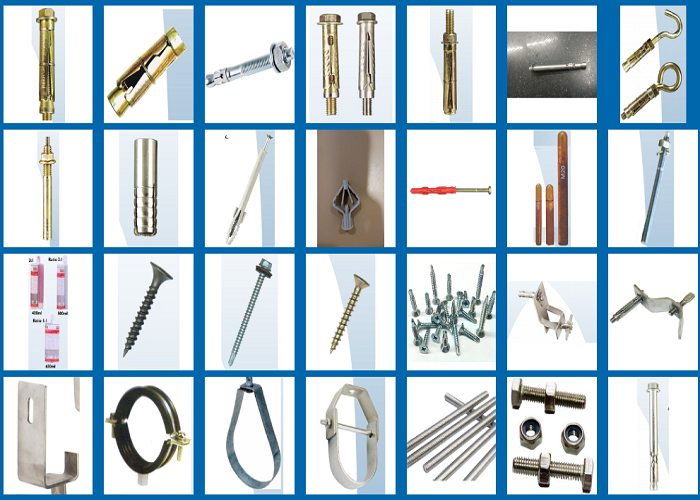




Mechanical or anchor fasteners provide a clamping force joining two pieces of material. There is a wide variety and types of fasteners and a variety of materials used to make them. There are threaded, non-threaded fasteners and fasteners for special purpose. Steel fasteners are the most common material used, although aluminium alloys, brass and nickel are amongst other metals used in wide range of available metal fasteners. Aluminium alloy fasteners have the advantage over steel of being much lighter, non-magnetic and more corrosion resistant fasteners. Nickel has the particular advantage of strength at high temperatures.
The choice of fastener will depend on a number of factors:
1. For example: high, normal and low temperature; corrosive, abrasive and oxidising conditions.
2. Nature of the external loading on the fastener…For example: tension, compression, shear, cyclic, impact.
3. Life and service requirements…For example: the need for perhaps frequent assembly and disassembly.
4. Design of the components being joined and types of materials…For example: stress concentrations; the elastic, plastic and thermal properties of the materials.
Quantity of fasteners required
Threaded fasteners
In a threaded fastener, the joining operation is done via clamping force between the two pieces of material, which is produced by a torque being applied to the fastener to stretch it and this is maintained during the service life of the fastener. The fastener is in tension and the two pieces of material in compression. Bolts that comes with screws and nuts with threads in the material are some of the examples of this type of fastener. Low- or medium-carbon steel bolts will typically have a minimum proof strength of about 225 to 400 Pa, the proof strength being the maximum stress the bolt can withstand without acquiring a permanent set. For quenched and tempered medium carbon bolts the minimum proof stress is 600 to 650 MPa and quenched and tempered alloy steel about 970 MPa. Threaded fasteners are particularly useful for joining components that are likely to need to be dismounted during the life of the product.
Non-threaded fasteners
Rivets, eyelets, nails and pins are examples of non-threaded fasteners. Rivets can be used for joining dissimilar or similar materials, both metallic and non-metallic, to give permanent joints. When the force being applied to the rivet is high enough, causing the deformation of plastic that eventually leads to the shank of the rivet increasing in diameter while decreasing its length. The part of the shank that is in the hole expands in diameter till it completely fills the hole while the unsupported shank outside the hole continues to deform until a head is formed. A pliable material must be used as the material for a rivet material, e.g. mild steel, copper, brass, aluminium alloy. For a few materials the needed ductility is attained in the cold state, while in others the riveting might takes place in hot state. Where the riveting force may distort or damage the materials being joined, semi-tubular or even tubular rivets can be used in place of solid rivets.
Pins, either in the solid or tubular forms, are widely used for fastening. For example, taper pins are used to join wheels onto the ends of shafts, the pin just being driven through holes in the two parts until it is fully home and giving a tight fit. Taper pins are usually supplied in mild steel but can be alloy steel, stainless steel or brass. Another form of pin is the split cotter pin. This is used where movement in the joint is required or as a locking device: for slotted nuts on bolts.
There is a wide range available with regard to the types of spring-retaining clips. However, the simplest among all is a C-clip that is used to lock parts on shafts, the clip usually fitting into a groove on the shaft. Most C-clips are crafted from tempered and hardened carbon steel.
Fatigue properties of fastened joints
The usage, for instance, of rivets or bolts as fasteners for joints can lead to fretting damage wherein fretting is the wearing process, which occurs at the areas of contact of two metals undergoing small cyclic slip. The damage is referred to as galling or scuffing. Such damage can lower the fatigue strength by factors as high as three for aluminium alloys.
Sundream Group is one of the trusted names involved in precise and quality metal and chemical fasteners along with many and most of the available types. The group is a prominent and leading manufacturer and supplier of superior quality anchor fasteners. For details on product quality and quantity and for any other queries, visit us at https://www.sundreamgroup.com/products/anchor-fasteners/